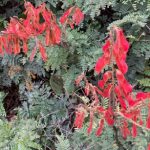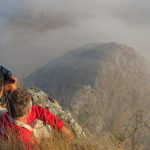TREE LIFE
SEPTEMBER 2022
505
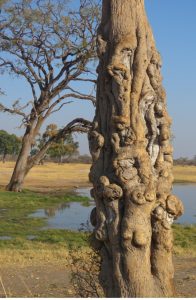
Gargoyle-trunk of tree Photo by Rob Jarvis
Welcome Everyone to this 505th Edition of Tree life.
On the left we see some pan accompanists from Hwange National Park in the northwest of Zimbabwe. There is no doubt that the gargoyle-trunk of the tree in the foreground has taken some punishment over the years, mainly from elephant and that the results are plain to see in the contorted faces etched into the bark and wood exposed. We were pleasantly surprised at the state of the Park and had the feeling that following the relatively good rainfall season of 2021/22 there is little evidence of mass degradation that one associates with the many waterholes, dams and pans of Hwange. Most in August had plentiful water, largely supplemented by solar systems financed and maintained largely by Friends of Hwange Trust.
The whole Park is looking good and we saw plentiful game everywhere and there is no finer place to seek out remarkable trees and even more remarkable woodlands, whether the teak forests, the false mopane or the true mopane woodlands with a surprising number of cathedral mopane.
For tourists there are many options from the budget camping right through to the five star pampered lodges!
Tree of the month
One for the Birds – Photos and Text by Ryan Trusscot
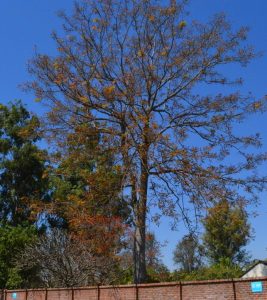
Acrocarpus fraxinifolius Photo by Ryan Trusscot
I have a soft spot for the Kenya Coffee Shade Tree. Here’s why.
Thirty-six years ago I was among the first intake of pupils at Hillcrest College, Mutare. Back then the school consisted of a single classroom block in the middle of wild grassland in the lee of the Cecil Kop range. To help develop the grounds each pupil was required to plant a tree on their birthday. My Mum got me a Kenya Coffee Shade Tree (Acrocarpus fraxinifolius) from the municipal nursery in Mutare. I planted and diligently watered and tended my tree. It might have grown to be a prominent landmark. Sadly the developers decided they needed to dig a trench along a line that included all the birthday trees planted that year, and out went my Kenya Coffee Shade Tree. Fast forward 30-odd years, and time has made up for that early loss. The house we moved into in Harare in 2017 has two large Kenya Coffee Shade Trees growing in the yard. There are also some magnificent ones growing in private gardens along the Arundel School Road, which I walk along most evenings. I look up in awe at their mighty boughs held aloft by thick, smooth trunks.
August is their time to shine. Their branches, stripped bare during the winter months, explode with a profusion of orange flowers borne on tapered racemes that resemble the glowing tips of aloes. The flowers are soon followed by a flush of fresh pink leaves that are fitting for a tree whose other common name is the Pink Cedar. The flowers are a magnet for all sorts of foraging birds: I’ve noticed amethyst sunbirds, dark-capped bulbuls and spectacled weavers feeding on mine. Across town the Friends of Hillside Park group has recorded at least 14 different species feeding on the flowers of theirs. Among them are fork-tailed drongos, green woodhoopoes and arrow-marked babblers.
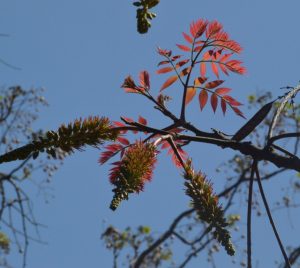
Acrocarpus fraxinifolius flowers Photo by Ryan Trusscot
The flowers serve a useful purpose for us humans too: all those trees you glimpsed from the car and thought were red mahoganies (Khaya anthotheca) during the previous year can now be positively identified as Kenya Coffee Shade Trees which, despite their name, are not native to that country. They originate from Burma, India, Java and Thailand. That begs the question: do they belong on our roadsides or golf courses, or in our school yards and parks, when there are indigenous substitutes like the red mahogany? Probably not. Still, I suspect I’d miss them if they weren’t there. A few months ago someone ringbarked the lovely one that stands at the entrance to the Mount Pleasant District Office along The Chase. Despite this mutilation, the tree is clinging to life. It has this month put on one last magnificent show of flowers.
The birds, at least, must be happy.
Lake Chivero Arboretum
by Tony Alegria
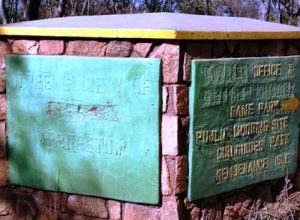
National Parks sign Photo by Jan van Bel
On Wednesday 3rd August, Jan van Bel, Graham Mills and I went to Lake Chivero to look at the Arboretum that the Tree Society of Rhodesia had set up many years ago. This was a reconnaissance to see if it was a worthwhile venue for a Sunday tree outing. When we reached the turnoff near the lake, we were surprised to see a prominent sign advertising the Tree Society of Rhodesia arboretum with the “Rhodesia” chipped off.
The place is very well treed with munondos being the dominant species, however there were many other species of trees present. I have never seen so many Bridelia cathartica on one site! Finding the arboretum amongst many trees wasn’t so easy; we just had to look for trees that were definitely planted there. We looked for trees that were “out of place” as this was not their natural habitat. We found Albizia gummifera, Craibia brevicaudata, Ficus lutea, Phoenix reticulata, Eucalyptus citriodora and a few others.
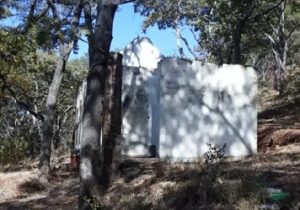
Ablution Block Photo by Tony Alegria
Strangely enough, there had been a functional ablution block at some time as can be seen from the photo.
This is definitely a suitable venue for a Sunday outing! I can only assume that the average age of a member then was a lot lower than at present! No wonder there are so many trees now, the stumps from wood cutting have had a lot of time to coppice and become mature trees. Digging into our website I found the two articles below which is an indication of just how much work was done to set up the arboretum some 70 years ago.
TREE LIFE 55
SEPTEMBER 1984
The Tree Society took over the land shortly after Lake McIlwaine had filled, in the early months of 1952. It consisted of a hill of banded iron stone which had been clear felled for firewood production some years before and the annual grass burn had kept regeneration at bay. Working from a survey by Mr. Jack Reid, contour paths were laid out. In those days exotics were regarded as being just as important as indigenous trees and so, many were planted. Today very few of them are still surviving.
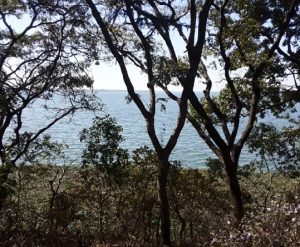
View of lake Photo by Tony Alegria
We walked along the road by the lake edge and saw, among others, Acacia amythethophylla, A. nigrescens, Albizia antunesiana, Bridelia cathartica, Burkea africana, Cassia singueana with its yellow flowers, Combretum zeyheri in fruit, Ochna schweinfurthiana, Pseudolachnostylis maprouneifolia, Uapaca kirkiana, Zanha africana and Craibia brevicaudata which are typical forest trees were planted as was Chlorophora excelsa which is normally found in low altitude evergreen forest.
ARBORETUM AT LAKE MCILWAINE
Those of us with any energy climbed the hill where we saw Garcinia buchananii, which usually has yellow milk in the leaves but it was difficult to see, probably due to the drought, Kirkia acuminata, Lannea discolor with its “E.T . Fingers” Pleurostylia africana and we were rewarded at the top by the sight of Ficus abutilifolia, a specimen of Euclea natalensis in flower and a wonderful view over to the Darwendale Dam. Our thanks to George and Margaret for showing us around.
Tree Society of Rhodesia Newsletter September 1959
At present water, so necessary to ensure good growth of young trees during the first one or two years of their establishment, must be hauled by hand from the lake. The labour and inconvenience of carrying water by the bucketful increase as the project extends up the hill. It is very desirable to open up and beautify the crest with plantings as it is a favourite view point for those willing to scramble five hundred feet upwards. The woodcutter, who devastated the slopes of the hill in the past, spared man of the trees on the crest, but they are, however, largely obscured and suppressed by scrub.
It is the Society’s intention to thin out the scrub up to the crest, preserving promising saplings and any specimens not common on Sentinel Hill, and, during this coming wet season, to interplant with colourful trees and shrubs wherever space can be made available. This work, and improvements to the path cut last year, will undoubtedly attract more visitors and may arouse their interest in trees; which, after all, is one of the objects of this Society. The view from the summit and the surroundings may be the initial attraction, but, as the arboretum develops, the beauty of the trees may well surpass the other attractions.
It is also certain that, observed from the lake, the hill will attract more attention. We may do no more than give a little pleasure to an unknown visitor, but it is almost certain he will spread the word around of a place well worth the expenditure of energy on a fifteen minute uphill walk. It is in such ways that the Society will grow in strength and numbers.
As is usually the case with any worthwhile project, there is a big snag to the development of the crest and upper reaches. While water can be carried manually for a short distance there are obviously limitations to this and if water is to be of benefit to the arboretum in general it must be pumped. The Committee has gone into ways and means of doing this and obtained an estimate of the cost, £300. This is, of course, far beyond the means of the Society, but it believes the scheme of pumping water to tanks at the top and part way up the slope is essential for the development of the crest and the upper slope. It is therefore, going into ways and means of raising the sum. Will any reader contribute towards this work?
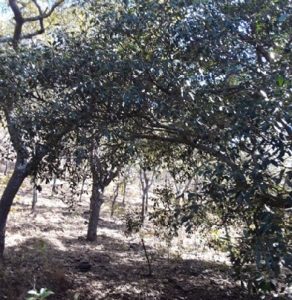
Well wooded Photo by Tony Alegria
What follows are further excerpts taken from various newsletters over the years:
From 1967 newsletters
A one time scene of desolation is to become a place of beauty of particular interest to tree lovers. It is Sentinel Hill and rises steeply on the west side of the dam wall of Lake McIlwaine. Thanks to the work of some members of the Tree Society and the good offices of the National Parks Board, a large area of scrub woodland is being slowly converted into an arboretum. The volunteer workers who go there weekends are not daunted by the knowledge that the task will take fifty years or more to complete. In little over a year a mark has been made that is visible from even the centre of the lake. Scrub has been cleared, leaving promising saplings of the more interesting or unusual species and some two hundred and fifty colourful and exotic trees have been planted.
From 1970 newsletters
The Arboretum was officially opened by the Society’s President, Sir Humphrey Gibbs on 10th September 1960 when he unveiled a plaque set in the stone bench which is on the same contour as the hut.
From 1971 newsletters
COMBINED OPERATION WILDFLOWER WITH THE ALOE SOCIETY: In spite of a lower than expected turn out of members of this Society to the combined exercise conducted with members of the Aloe, Cactus and Succulent Society to transfer aloes to the Lake McIlwaine Arboretum, the result was most successful. Between twelve and fifteen hundred specimens of Aloe chabaudii were removed from a site in the vicinity of the confluence of the Ruwa and Hunyani rivers which will soon be inundated due to the building of a new dam and replanted at the Arboretum. To all those members who were able to take part as well as to the helpers from our sister society may I say thank you very much for all their very hard work.
From 1974 newsletters
LAKE MCILWAINE, TREE SOCIETY’S ARBORETUM. Members have created a pleasant woodland area adjacent to the wall and overlooking the lake. There is Doug Newmarsh’s stone seat, David’s Den, the wooden hut, a landing jetty and small aloe garden, all kept tidy by Anderson, who works for both us and National Parks under the eye of Col. Kemp.
From 1977 newsletters
Lake McIlwaine Arboretum I am sorry to say that we have seen very little of the Lake McIlwaine Arboretum in the past two or three years. After the tremendous amount of planning, surveying, mapping, clearing, road making, landscaping and planting, which the Committees of the late 1950’s and 1960’s and even the early 1970’s put into the Arboretum, it is sad that we are able to visit it so seldom. If there are any members living in the vicinity who could spare the time to involve themselves in some clearing and thinning operations and perhaps a minimal amount of planting, it would be a great boon, for it is a lovely area, and one of which the older members of the Society are justifiably proud.
Lake McIlwaine Arboretum on 21st August 1977. The more energetic members scaled the heights only to find the view of the new Darwendale Dam obscured by haze. However, they brought back a leaf of Ficus soldanella from the summit to prove their agility, and a collection of other leaf specimens for discussion during the lunch break. Among these was Hexalobus monopetalus and Dalbergia melanoxylon; and the long narrow leaf of Ficus salicifolia, which used to be F. pretoriae and which, but for the narrowness and length of the leaf, is so easily confused with F. burkei, a personal observation which the botanist would doubtless scorn. At least one of several Faurea speciosa trees was still in flower. Fagaropsis angolensis was found on the fringe of the cleared area which on successive visits, looks ever more park like by comparison with the dense growth of the adjacent woodland and upper slopes. We had with us an aerial photograph of the mid-50’s, a picture of desolation following years of tree cutting on the hillsides of Hunyani Poort and it was most heartening to be able to view the transformation brought about by 20 years of protection, and all the planning and many years of sustained work of Tree Society members of the 1950’s and 1960’s in cooperation with the Department of National Parks and the now retired Water Bailiff, Col. Kemp.
From Tree Life 142 Dec 1991
We have been forced to observe the decline before our very eyes; the ram pump broke down; the piping was stolen; David’s Den, the delightful little rustic hut was stolen piece by piece and what we had considered virtually indestructible, the ironstone bench – Doug’s Seat, went the same way. But, and this I stress, the natural environment of the arboretum, solidly set on course by the hard workers in the early days, has thus far survived all the vandalism of our man-made structures.
TREE LIFE 55 Sept 1984
The Tree Society took over the land shortly after Lake McIlwaine had filled, in the early months of 1952. It consisted of a hill of banded iron stone which had been clear felled for firewood production some years before and the annual grass burn had kept regeneration at bay. Working from a survey by Mr. Jack Reid, contour paths were laid out. In those days exotics were regarded as being just as important as indigenous trees and so, many were planted. Today very few of them are still surviving.
We walked along the road by the lake edge and saw, among others, Acacia amythethophylla, A. nigrescens, Albizia antunesiana, Bridelia cathartica, Burkea africana, Cassia singueana with its yellow flowers, Combretum zeyheri in fruit, Ochna schweinfurthiana, Pseudolachnostylis maprouneifolia, Uapaca kirkiana, Zanha africana and Craibia brevicaudata which are typical forest trees were planted as was Chlorophora excelsa which is normally found in low altitude evergreen forest.
We have decided to have an all day outing to the Arboretum on the fourth Sunday of next month, 25th September, which will suit Meg who had dealings with the arboretum many years ago. I don’t want to leave it later than that as it will get too hot for those who may have the energy to get to the top of Signal Hill!
The Stories That a Tree Can Tell
By Rob Jarvis
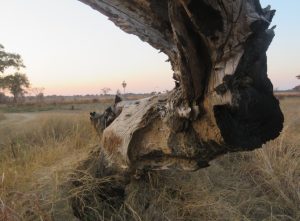
Dead tree Photo by Rob Jarvis
We recently visited a fairly new operation at a camp called Silwane, just on the edge of the south-western boundary of Hwange National Park and camped there for a couple of nights. Wonderful place and it is now a Nature Sanctuary with ready access to the Kennedy and Ngweshla Pans across the railway line. Under the dead tree, the camp hands showed us an ant-bear hole that had previously been occupied by a large python. She had moved on they said. However by using a torch and zooming in with the camera we saw that the python was still very much in residence!
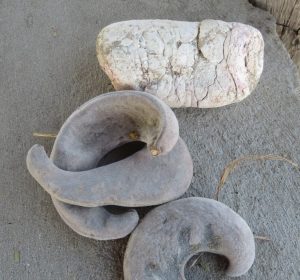 Not far away on an adjacent anthill we found the items pictured right. The pods of Acacia erioloba are well known and had fallen from the living tree above our camp. However the white item, which is scat of some sort, we initially thought it might have come from a hyena or perhaps a lion if he had totally munched the bones.
Not far away on an adjacent anthill we found the items pictured right. The pods of Acacia erioloba are well known and had fallen from the living tree above our camp. However the white item, which is scat of some sort, we initially thought it might have come from a hyena or perhaps a lion if he had totally munched the bones.
The other possibility is that it might be the calcium waste passed by a large python, some weeks or even months after eating and finally digesting an antelope????
If so, good to see they defecate away from their homes.
Tree Walk at Pauline and Brian Ballinger’s Greendale Home
Text and photos by Rob Jarvis
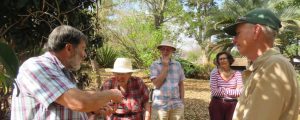
The Ballinger’s garden Photo by Rob Jarvis
A warm afternoon in August saw the Society visiting the very interesting garden of the Ballinger’s in Greendale. The basement rock hereabouts is dolerite and perhaps a touch of banded ironstone and as is so often the case, water is hard to find. The Ballingers have opted for a woodland garden with very few beds of flowers and succulents and the lawn takes its chances with the dry season. There was a grand Ficus sycomorus thriving in the next door garden, probably an indicator that there is water there, underfoot. We found Zimbabwe’s ubiquitous date palm, Phoenix reclinata, the much favoured Euphorbia tirucalli, and one of Africa’s iconic trees, especially from East Africa where they are known as the tulip tree: Spathodia campanulata, our evergreen Trichelia emetica, the athletic-looking Kenyan Croton megalocarpus, the horrible Castor oil: Ricinus communis, the darling of the health nuts, Moringa, our own large-leaved dracaena: Dracaena steudneri, Grevillea robusta, Guava, Albizia spp, Ficus burkei.
Whilst walking past a garden shed, we were surprised to see a Triffid-like explosion of plant life trying to escape through the window. We hurried on lest we were incarcerated as well. Neither Pauline, nor Brian could explain what had caused these plants to be locked up!
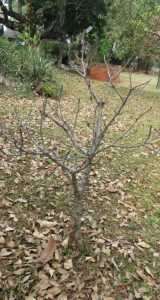
Baobab not doing well! Photo by Rob Jarvis
Later we chanced upon a flamboyant from Madagascar Delonix regia, Jatropha spp, curry tree or sweet neem: Murraya koenigii, Acacia karoo, Podocarpus latifolius, the edible Guiana chestnut, a wetland native from central and south America and which has more common names than a Murphy from Ireland and can be known as the Malabar chestnut, French peanut, Money tree, Provision tree, Saba nut, Monguba, Pumpo, Pachira aquatica, Celtis africana, Kigelia africana, Erythrina lysistemon, seen above, right, an absolute profusion of flowers, Carob tree which needs male and female trees to fruit, the humble munondo; Julbernardia globiflora, towering specimens of red mahogany Khaya anthotheca, and the pink cedar: Acrocarpus fraxinifolius, Queen palm: Syagrus romanzoffiana, Ficus sur, Acacia polyacantha and Vangueria infausta peeking over the boundary wall. The latter two species were thriving in the roadside drainage ditch off the road outside the property.
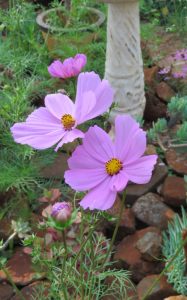
When on rocky territory I guess the exact selection of a site to plant a favoured tree is critical. Above right we see a baobab that had been planted some years ago but it definitely has not thrived. Perhaps it is right on top of some shallowly covered bedrock. On the left we see an early flowering cosmos, visually reinvigorating us, just before we took the welcome tea and delicious sandwiches offered by Pauline and Brian.
Photo – Rob Jarvis
Tree Society Committee and Contacts
Chairman Tony Alegria tonyalegria47@gmail.com 0772 438 697
Vice Chairman Rob Jarvis bo.hoom52@yahoo.com 0783 383 214
Honorary Treasurer Bill Clarke wrc@mweb.co.zw 0772 252 720
Projects Jan van Bel jan_vanbel@yahoo.com 0772 440 287
Venue Organiser Ann Sinclair jimandannsincs@zol.co.zw 0772 433 125
Tree of the Month Ryan Truscott ryan.kerr.truscott@gmail.com 0772 354 144
Secretary Teig Howson teig.howson@gmail.com 0772 256 364
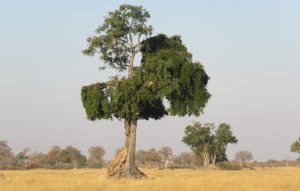
Browse-line on tree Photo by Rob Jarvis
We visited Hwange and Victoria Falls during August and more on this later, but how we wished we were there when the perpetrators actually were at work making this browse-line on these trees near the Kennedy pans in the southern area of HNP. Elephant or giraffe? Baboons probably roost on the lateral branch on the middle-left of the trees. Next time!


